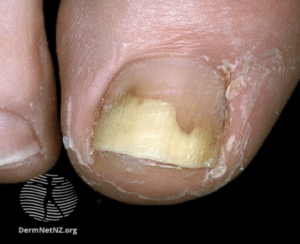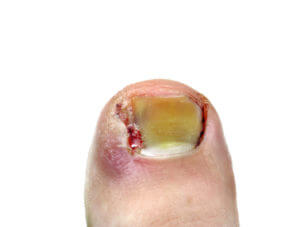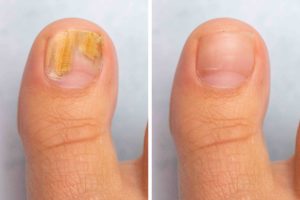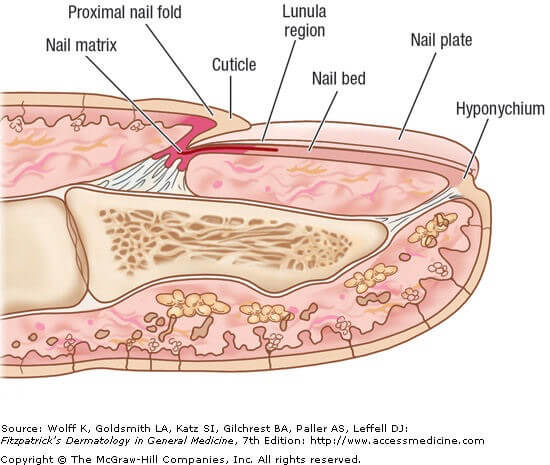Nail Toxicity after cancer treatment
Preventative actions when it comes to toxicity after cancer treatment hopefully can avoid disruption to the patient’s treatment cycle and ensure their mobility need not be affected by painful nails. Reading score = 52

Onycholysis DermNetNZ.org ? nail toxicity after cancer treatment
Here are three types of conditions that can affect the nail:
Onycholysis – separation of the nail
Involution – the nail starts to excessively curl creating a pinching effect of the skin at the sides. This can lead to painful ingrown toenails and can quickly become infected.
Fungal and bacterial infections – the nail can start to discolour, thicken and crumble. This is due to the drugs affecting cells with a high turnover rate such as nails and coupled with a weakened immunity, it allow opportunistic fungal infections to take hold.
Onycholysis
The nail separates from the nail bed and once this tight contact is lost the nail appears white and gaps provide a cavern for loose material to build up. This is called onycholysis. Onycho- (nail) and – lysis (separation). Professional management is critical at a point where there is risk from poor healing during chemotherapy. Attention to good skin care, prevention of infection and protection from fragile skin tearing as a result of nail cutting is important. The nail is usually cut back painlessly to expose healthy nail bed which if left can lead to skin forming an ulcer. Ulcers imply a slow heal loss of surface skin. Any unhealthy material is removed to reduce any pressure under the toe nail. This may not look pretty but it is a safe method in professional hands to limit nail bed damage.
Management from onycholysis is more about maintaining a status quo. The intervention prevents the skin around the nail from becoming inflamed (paronychia) and secondary infection of the nail fold and bed. Nail surgery is inadvisable because of the reduced healing potential when patients are having chemotherapy or radiotherapy.
Involution and Ingrown toenails

The left side – skin overgrows
Pain and problems in the grooves of the nail due to the nail curling inward may require alleviation from pressure and prevention from the nail sides digging into the skin. If left unattended an ingrown toe nail may result. It is important to see a podiatrist during this time to prevent pain and infections occurring. Permanent damage to the nail arises after long periods of cancer therapy. Frozen sock therapy or certain gel socks protocol used at our clinic Tiptoe Foot Care has been found to reduce nail toxicity, particularly in patients taking docetaxel. The application of antiseptics can help limit infection at the start.
Fungal Infection

Fungal Nail infection and healthy nail after treatment. These conditions are stubborn.
If a nail is suspected of an initial fungal infection, quick action taken is best to stop it in its tracks. Seeing your podiatrist to have as much of the fungus cut back as possible will help and they will be able to advise you on the best form of topical medication to use depending on the type of fungus it is. It can be valuable to take a sample for identification.
More information on this site
Five Conditions in feet caused by medication to treat cancers
Cancer and the foot
Supplementary facts and podiatry from Afni Shah-Hamilton
How can podiatry help with peripheral neuropathy?
How can podiatrists help with hand-foot syndromes?
How can podiatrists help dry skin?
Thanks for reading ‘Nail toxicity after cancer treatment’ by Afni Shah-Hamilton

Published by Busypencilcase Reflective Communications.
April 2020. Reviewed 28 March 2021


Recent Comments